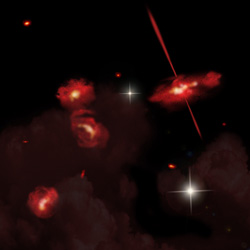Strange New "Species" of Ultra-Red Galaxy Discovered

It took the revealing power of NASA's Spitzer Space Telescope to uncover not one, but four remarkably red galaxies. And while astronomers can describe the members of this new “species,” they can't explain what makes them so ruddy.
“We've had to go to extremes to get the models to match our observations,” said Jiasheng Huang of the Harvard-Smithsonian Center for Astrophysics (CfA). Huang is lead author on the paper announcing the find, which was published online by the Astrophysical Journal.
Spitzer succeeded where Hubble failed because Spitzer is sensitive to infrared light – light so red that it lies beyond the visible part of the spectrum. The newfound galaxies are more than 60 times brighter in the infrared than they are at the reddest colors Hubble can detect.
Galaxies can be very red for several reasons. They might be very dusty. They might contain many old, red stars. Or they might be very distant, in which case the expansion of the universe stretches their light to longer wavelengths and hence redder colors (a process known as redshifting). All three reasons seem to apply to the newfound galaxies.
All four galaxies are grouped near each other and appear to be physically associated, rather than being a chance line-up. Due to their great distance, we see them as they were only a billion years after the Big Bang – an era when the first galaxies formed.
“Hubble has shown us some of the first protogalaxies that formed, but nothing that looks like this. In a sense, these galaxies might be a 'missing link' in galactic evolution” said co-author Giovanni Fazio of the CfA.
Next, researchers hope to measure an accurate redshift for the galaxies, which will require more powerful instruments like the Large Millimeter Telescope or Atacama Large Millimeter Array. They also plan to search for more examples of this new “species” of extremely red galaxies.
“There's evidence for others in other regions of the sky. We'll analyze more Spitzer and Hubble observations to track them down,” said Fazio.
NASA's Jet Propulsion Laboratory, Pasadena, Calif., manages the Spitzer mission for NASA's Science Mission Directorate. Science operations are conducted at the Spitzer Science Center at the California Institute of Technology in Pasadena. NASA's Goddard Space Flight Center built Spitzer's Infrared Array Camera, which took the observations. The instrument's principal investigator is Giovanni Fazio of CfA.
Headquartered in Cambridge, Mass., the Harvard-Smithsonian Center for Astrophysics (CfA) is a joint collaboration between the Smithsonian Astrophysical Observatory and the Harvard College Observatory. CfA scientists, organized into six research divisions, study the origin, evolution and ultimate fate of the universe.
For more information, contact:
David A. Aguilar
Director of Public Affairs
Harvard-Smithsonian Center for Astrophysics
617-495-7462
daguilar@cfa.harvard.edu
Christine Pulliam
Public Affairs Specialist
Harvard-Smithsonian Center for Astrophysics
617-495-7463
cpulliam@cfa.harvard.edu
Media Contact
More Information:
http://www.cfa.harvard.edu/All latest news from the category: Physics and Astronomy
This area deals with the fundamental laws and building blocks of nature and how they interact, the properties and the behavior of matter, and research into space and time and their structures.
innovations-report provides in-depth reports and articles on subjects such as astrophysics, laser technologies, nuclear, quantum, particle and solid-state physics, nanotechnologies, planetary research and findings (Mars, Venus) and developments related to the Hubble Telescope.
Newest articles

Superradiant atoms could push the boundaries of how precisely time can be measured
Superradiant atoms can help us measure time more precisely than ever. In a new study, researchers from the University of Copenhagen present a new method for measuring the time interval,…

Ion thermoelectric conversion devices for near room temperature
The electrode sheet of the thermoelectric device consists of ionic hydrogel, which is sandwiched between the electrodes to form, and the Prussian blue on the electrode undergoes a redox reaction…

Zap Energy achieves 37-million-degree temperatures in a compact device
New publication reports record electron temperatures for a small-scale, sheared-flow-stabilized Z-pinch fusion device. In the nine decades since humans first produced fusion reactions, only a few fusion technologies have demonstrated…





















